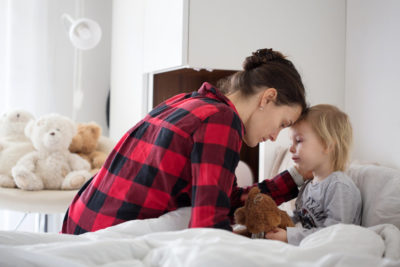An essential part of parenting is keeping your children away from harmful substances. However, these substances are often found in everyday items, and their presence may not be obvious.
One of these substances is asbestos, a naturally occurring mineral that was a popular building material used up until the 1980s. Although laws were created to protect the public from this carcinogen, asbestos has still not been eradicated in the U.S.
Exposure to asbestos can cause severe health complications. One of which being mesothelioma, an aggressive cancer that affects the lining of organs such as the lungs, heart, and abdomen. Like other asbestos-related illnesses, it can take anywhere from 10 to 50 years for mesothelioma to develop. This means that preventing your child from exposure now could save their lives in the future. Because children’s lungs are still developing and more susceptible to toxins, it’s important to keep asbestos away from them.
In honor of Mesothelioma Awareness Day— which happens annually on September 26th— we’ve compiled a list of common places your child can become exposed to asbestos, as well as ways to reduce your child’s risk for developing asbestos-related diseases.
Crayons and Toys
Every school year parents are given a list of items that their child needs in order to be successful. And every year crayons are a must-have on this list. However, these items have been found to contain asbestos. Popular brand Playskool has been found to contain toxic levels of asbestos in its crayons, which was discovered in multiple investigations over the years.
Other toys that have been found to contain asbestos in the past include fingerprinting sets, clay sets, and children’s makeup. All of these products used talc as a sticking agent, which is a mineral that is often contaminated with asbestos.
Home repairs
Another common dwelling place for asbestos is right in our homes. A lot of houses built before 1980 used asbestos in areas such as insulation, floor tiles, walls, heating and cooling systems, popcorn ceilings, and other building products. Unfortunately, you can’t tell if something was made with asbestos just by looking at it.
So long as these asbestos-containing materials remain undisturbed, they don’t really pose a threat to your family. However, home renovations and DIY projects could release asbestos dust into the air that can cause harm to you and your children.
Old Schools and Playgrounds
Some records indicate nearly a third of the nation’s schools may have been built with asbestos products. As school buildings age, older asbestos materials have begun to decay and release fibers. As a result, teachers and children may experience exposure. Schools heavily relied on the material when constructing classrooms, auditoriums, school corridors, and other high-traffic areas. In geographic areas (predominantly regions of the western US and some within the East Coast) where serpentine rock is common, asbestos-contaminated serpentine may have been used for surfacing in schoolyards and playgrounds. Because of this, teachers are actually one of the highest-risk occupations of developing mesothelioma and other asbestos-related diseases.
Children are also at risk of being exposed to asbestos in this setting. This is especially dangerous for young children because they breathe faster than adults and tend to breathe from their mouths rather than their noses. They’re also more active and tend to spend a lot of time on the floor, where loose asbestos fibers can accumulate.
The Philadelphia School District made national headlines in May of 2018 after an investigation uncovered several environmental hazards within schools across the district. By the fall of 2019, 11 schools were partially or fully closed due to extreme risks of asbestos exposure for students and teachers. Lea DiRusso, a teacher for the district, was diagnosed with mesothelioma after teaching at two asbestos-containing schools for nearly 30 years. It’s crucial for districts to properly test classrooms and schools in order to protect their employees and students.
Secondary Exposure
Unfortunately, even if your family lives in a brand new house and your child doesn’t play with asbestos-contaminated toys, they still run the risk of being exposed to the toxic mineral. Parents who work in high-risk occupations can expose their families to asbestos. These occupations include but are not limited to:
- Firefighters
- Auto mechanics
- Construction workers
- Teachers
- HVAC Workers
- Machine operators
- Electricians
- Plumbers
People working in these professions can carry loose asbestos fibers into their homes, either on their clothes or work equipment. These fibers can be breathed in by household members, which increases their risk of developing mesothelioma.
How To Reduce Risk of Asbestos Exposure
No amount of asbestos exposure is safe, so it’s important to minimize your child’s encounters with this mineral as much as possible.
Avoid toys and consumer products made with talc. Check the ingredients of powdery products to make sure the product doesn’t contain talc.
Find out if your child’s school contains asbestos. Schools are required by the AHERA to have their plans for asbestos removal publicly accessible. If you’re worried that your child’s school may contain asbestos, you can contact the school’s administration to find out more information.
Discourage playing in or near abandoned houses, building sites, or demolition areas. These settings are prone to having loose asbestos fibers in the air and should be avoided.
It’s important to remember that the mere presence of asbestos does not mean that your child will automatically develop mesothelioma. However, it’s best to keep them away from any potentially toxic materials if you want to keep them safe and healthy.

